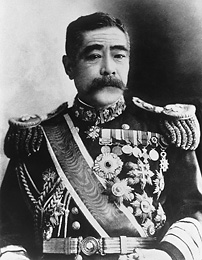Difference between revisions of "Saigo Tsugumichi"
m (added category) |
m (added image and info) |
||
| Line 1: | Line 1: | ||
* ''Birth: [[1843]]'' | * ''Birth: [[1843]]'' | ||
* ''Death: [[1902]]'' | * ''Death: [[1902]]'' | ||
| + | * ''Title: Koshaku (Marquis)'' | ||
| + | [[Image:Saigotsugumichi.jpg|left|frame|Photograph of '''Saigo Tsugumichi'''.]] | ||
Tsugumichi was a younger brother of [[Saigo Takamori]]. During the [[Bakumatsu Period]], he had a distinguished military career, fighting in battles across Japan. After the [[Meiji Restoration]], he was appointed a general of the Imperial army, and led the Tokyo military garrison. In [[1873]], Tsugumichi and his brother Takamori had a strong disagreement over the proposed invasion of Korea (Takamori argued for invasion, whereas Tsugumichi was against it), and eventually had a falling out, with Takamori resigning from government. | Tsugumichi was a younger brother of [[Saigo Takamori]]. During the [[Bakumatsu Period]], he had a distinguished military career, fighting in battles across Japan. After the [[Meiji Restoration]], he was appointed a general of the Imperial army, and led the Tokyo military garrison. In [[1873]], Tsugumichi and his brother Takamori had a strong disagreement over the proposed invasion of Korea (Takamori argued for invasion, whereas Tsugumichi was against it), and eventually had a falling out, with Takamori resigning from government. | ||
| Line 10: | Line 12: | ||
In [[1877]], when the [[Satsuma Rebellion]] broke out, Tsugumichi wanted to take up arms against his brother, however the government declined his request. He did supply the Imperial army with food and ammunition from Tokyo during the rebellion, which contributed to the Imperial victory. | In [[1877]], when the [[Satsuma Rebellion]] broke out, Tsugumichi wanted to take up arms against his brother, however the government declined his request. He did supply the Imperial army with food and ammunition from Tokyo during the rebellion, which contributed to the Imperial victory. | ||
| + | |||
| + | He became minister of the Navy in [[1885]], and became an admiral in [[1894]], serving in the [[Sino-Japanese War]]. He became a fleet admiral in [[1898]]. | ||
| + | |||
==References== | ==References== | ||
* Lanman, Charles. ''Japan - Its Leading Men'' D. Lothrop & Co., Boston, 1886. ''(Public Domain source)'' | * Lanman, Charles. ''Japan - Its Leading Men'' D. Lothrop & Co., Boston, 1886. ''(Public Domain source)'' | ||
| + | * [http://www.ndl.go.jp/portrait/e/index.html Portraits of Modern Japanese Historical Figures] | ||
[[Category:Samurai]][[Category:Edo Period]][[Category:Bakumatsu]] | [[Category:Samurai]][[Category:Edo Period]][[Category:Bakumatsu]] | ||
[[Category:Meiji Period]] | [[Category:Meiji Period]] | ||
Revision as of 18:22, 28 May 2007
Tsugumichi was a younger brother of Saigo Takamori. During the Bakumatsu Period, he had a distinguished military career, fighting in battles across Japan. After the Meiji Restoration, he was appointed a general of the Imperial army, and led the Tokyo military garrison. In 1873, Tsugumichi and his brother Takamori had a strong disagreement over the proposed invasion of Korea (Takamori argued for invasion, whereas Tsugumichi was against it), and eventually had a falling out, with Takamori resigning from government.
Tsugumichi led a Japanese invasion of Formosa (Taiwan) in May, 1874 (Taiwan Expedition of 1874), capturing the island after several battles.
In 1876, Tsugumichi was appointed the vice commisioner of the Japanese section of the World's Fair, held in Philidelphia, Pennsylvania.
In 1877, when the Satsuma Rebellion broke out, Tsugumichi wanted to take up arms against his brother, however the government declined his request. He did supply the Imperial army with food and ammunition from Tokyo during the rebellion, which contributed to the Imperial victory.
He became minister of the Navy in 1885, and became an admiral in 1894, serving in the Sino-Japanese War. He became a fleet admiral in 1898.
References
- Lanman, Charles. Japan - Its Leading Men D. Lothrop & Co., Boston, 1886. (Public Domain source)
- Portraits of Modern Japanese Historical Figures
